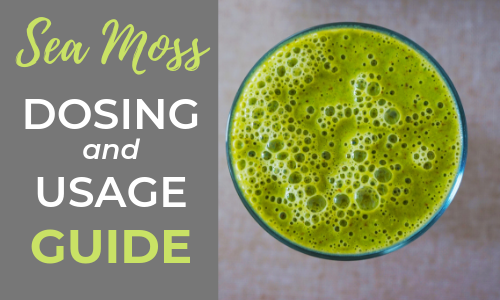Wondering how much sea moss to take daily? Dosage largely depends on what you're using it for, though there are recommendations for general use.
We'll discuss those along with the different forms of sea moss to help you decide which type is right for you.
What Is Irish Sea Moss?
Irish sea moss is a seaweed famous for its rich measure of minerals and antioxidants. It is believed to be native to the Atlantic Coast of Europe and North America.
However, today it is primarily used to thicken smoothies and milk in the Caribbean.
There are two main categories of sea moss on the market:
- Whole Irish moss of the gracilaria variety
- The Chondrus crispus species
The difference is that the gracilaria variety is usually sold as a whole seaweed while the Chondrus crispus is sold as dried flakes.
Chondrus crispus is higher in nutrients but has a stronger flavor hence a less desirable ingredient for use in food. On the other hand, the gracilaria sea moss variety is almost tasteless, albeit, with a subtle scent of seaweed.
The scent is hardly noticeable, especially when the seaweed is camouflaged in food or drinks. Since it takes on the flavor of the food it is used in, gracilaria sea moss is most commonly used in food.
Benefits of Irish Sea Moss
Irish Sea Moss is popular for its many health benefits, which include:
- Thyroid support in cases of low iodine levels
- Improvement of mental function
- Better emotional health
- Prevention of nasal congestion
- Treatment of chronic obstructive pulmonary diseases such as bronchitis
Sea moss also possesses antiviral properties that aid in fighting respiratory infections such as sore throats and even the flu.
As for its nutrient profile, out of the 102 minerals that make up the human body, Irish sea moss contains a whopping 92 of them.
On top of that, it contains protein, vitamin B, beta carotene, sulfur, pectin, and vitamin C. Sea moss can also work as a mild laxative, making it effective in soothing gut inflammation and promoting the elimination of waste.
Different Ways to Supplement with Sea Moss
1. Tinctures
Sea moss tinctures are quite common. Tinctures are used to effectively draw out essential compounds within the plant and are especially convenient for those who can’t swallow pills.
Besides that, tinctures are loved for their easy storage and quick absorption. They also allow for more precise changes in dosage as you can control the amount you consume down to the drop.
If the taste of sea moss is too strong in a tincture, you can easily mix it with juice to mask the taste.
2. Sea Moss Gel
Sea moss gel is gaining popularity because of its ease of use. It’s a favorite among chefs who make a wide variety of desserts, foods, and drinks.
As an ingredient, sea moss gel transforms the texture of food and helps in binding the fats and liquid constituents of food.
It is made exclusively from unprocessed seaweed and is hailed for being incredibly nutritious with few calories.
With a high-speed blending device, you can make sea moss gel at home. However, you should note that the Chondrus crispus variety of sea moss produces a darker gel, which may not be as pleasant as the gracilaria variety.
3. Capsules or Pills
Both capsules and tinctures have the same strength as far as their therapeutic benefits are concerned, though tinctures tend to absorb quicker.
The main difference between the two is that capsules take much longer to break down and digest, usually about 20 to 30 minutes. On the contrary, tinctures start being absorbed as soon as they get into the body, starting with mucous membranes in the oral cavity to the entire lining of the gut.
Nevertheless, capsules are recommended for those who are sensitive to alcohol or who can’t consume it for medical or religious reasons.
Note: This is one reason why we at Khroma Herbs only make glycerin-based tinctures, making the benefits and faster absorption rate of tinctures available to all people.
4. Sea Moss Powder
Sea moss powder is another effective way to supplement with Irish seaweed. To make this version, you’ll need whole seaweed that’s been dried, which you’ll crush into a fine powder.
Sea moss powder is best used as a spice for foods and is increasingly gaining popularity as a way to increase the nutritonal value of smoothies.
However, the efficacy of sea moss powder is greatly affected by environmental factors, so proper storage and quick use is key.
How Much Sea Moss to Take Daily
As mentioned previously, Irish sea moss is loaded with nutrients and minerals - one of the most abundant being iodine, which plays a key role in thyroid function.
It’s important to note that optimal function within our bodies is accomplished when there is a perfect balance of necessary nutrients.
This balance - or homeostasis - is important. Too much iodine can throw that delicate balance out of whack just as much as too little iodine could.
Although, modern-day diet and lifestyles make it hard to get too much iodine, so that’s generally not a concern.
With all this in mind though, you don’t want to overdo it on sea moss. The recommended quantity and dosage of sea moss is about 1 to 2 tablespoons. That translates to about 4 to 8 grams of sea moss per day.
If you were to supplement with a sea moss tincture like our Organic Irish Moss, the recommended dose is about 3 droppers full once daily.
Possible Sea Moss Side Effects
Most of the adverse side effects of Irish moss is dependent on the person using it. For this reason, it’s advised that you consult your doctor before using any form of Irish moss.
Though sea moss is perfectly safe for the general population, there are certain groups who should avoid it.
For instance, Irish moss is particularly contraindicated in people who have low blood pressure or those patients who are taking sympathomimetic or anticoagulant prescription drugs. It has been found that Irish moss can interact with these medications and worsen their side effects.
Due to its characteristically high levels of iodine, people with certain thyroid conditions should discuss use with their physician.
The Benefit of Combining Sea Moss with Bladderwrack For Extra Effect
Just like sea moss, bladderwrack is also a seaweed widely used for its health benefits.
It is mostly used to manage thyroid disorders, especially disorders associated with an inadequate amount of iodine in the body.
Combining bladderwrack and sea moss is appropriate because they have synergistic effects, especially when managing thyroid conditions due to low iodine. In many cases, the effect of these two supplements combined is greater than when they are used separately.
When combined, sea moss and bladderwrack help alleviate gastrointestinal problems such as constipation and bloating.
They also work to cleanse your blood and prevent coronary artery diseases and heart problems.

